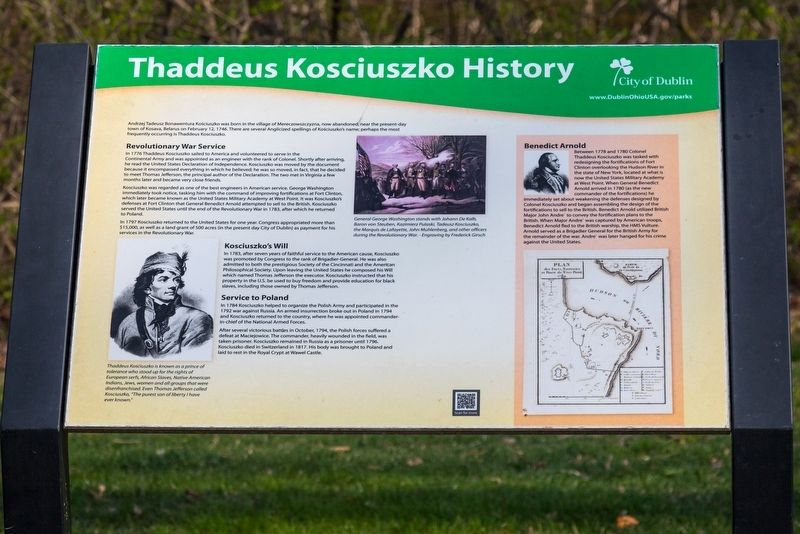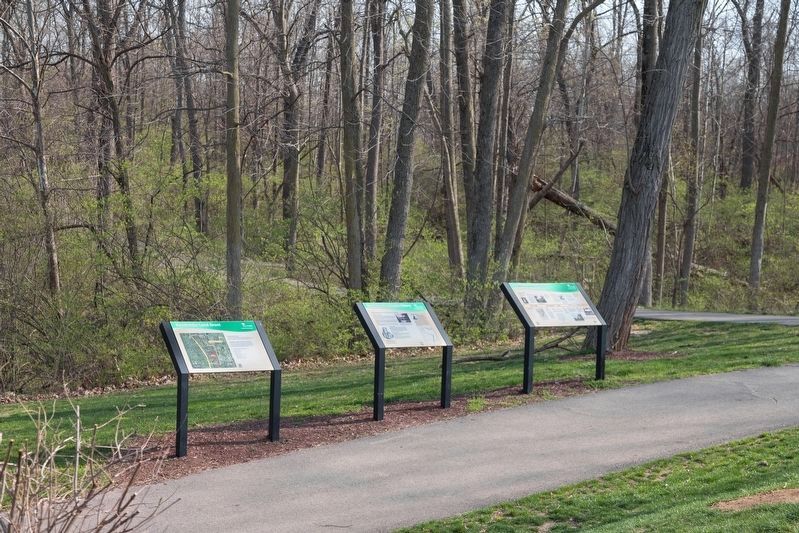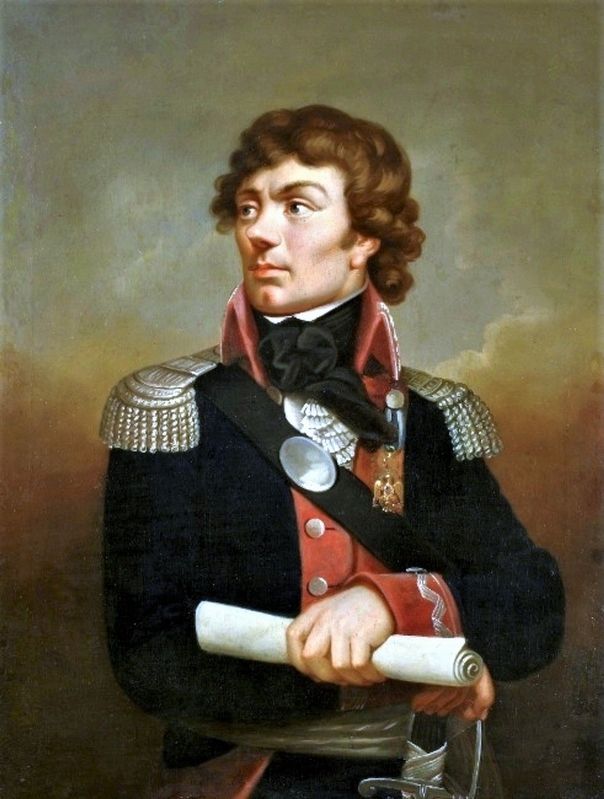Dublin in Franklin County, Ohio — The American Midwest (Great Lakes)
Thaddeus Kosciuszko History
Revolutionary War Service. In 1776 Thaddeus Kosciuszko sailed to America and volunteered to serve in the Continental Army and was appointed as an engineer with the rank of Colonel. Shortly after arriving, he read the United States Declaration of Independence. Kosciuszko was moved by the document because it encompassed everything in which he believed; he was so moved, in fact, that he decided to meet Thomas Jefferson, the principal author of the Declaration. The two met in Virginia a few months later and became very close friends.
Kosciuszko was regarded as one of the best engineers in American service. George Washington immediately took notice, tasking him with the command of improving fortifications at Fort Clinton, which later became known as the United States Military Academy at West Point. It was Kosciuszko's defenses at Fort Clinton that General Benedict Arnold attempted to sell to the British. Kosciuszko served the United States until the end of the Revolutionary War in 1783, after which he returned to Poland.
In 1797 Kosciuszko returned to the United States for one year. Congress appropriated more than $15,000, as well as a land grant of 500 acres (in the present day City of Dublin) as payment for his services in the Revolutionary War.
Kosciuszko’s Will. In 1783, after seven years of faithful service to the American cause, Kosciuszko was promoted by Congress to the rank of Brigadier-General. He was also admitted to both the prestigious Society of the Cincinnati and the American Philosophical Society. Upon leaving the United States he composed his Will which named Thomas Jefferson the executor. Kosciuszko instructed that his property in the U.S. be used to buy freedom and provide education for black slaves, including those owned by Thomas Jefferson.
Service to Poland. In 1784 Kosciuszko helped to organize the Polish Army and participated in the 1792 war against Russia. An armed insurrection broke out in Poland in 1794 and Kosciuszko returned to the country, where he was appointed commander- in-chief of the National Armed Forces.
After several victorious battles in October, 1794, the Polish forces suffered a defeat at Maciejowice. The commander, heavily wounded in the field, was taken prisoner. Kosciuszko remained in Russia as a prisoner until 1796. Kosciuszko died in Switzerland in 1817. His body was brought
to Poland and
laid to rest in the Royal Crypt at Wawel Castle.
(sidebar)
Benedict Arnold. Between 1778 and 1780 Colonel Thaddeus Kosciuszko was tasked with redesigning the fortifications of Fort Clinton overlooking the Hudson River in the state of New York, located at what is now the United States Military Academy at West Point. When General Benedict Arnold arrived in 1780 (as the new commander of the fortifications) he immediately set about weakening the defenses designed by Colonel Kosciuszko and began assembling the design of the fortifications to sell to the British. Benedict Arnold utilized British Major John Andre to convey the fortification plans to the British. When Major Andre was captured by American troops, Benedict Arnold fled to the British warship, the HMS Vulture. Arnold served as a Brigadier General for the British Army for the remainder of the war. Andre was later hanged for his crime against the United States.
Topics. This historical marker is listed in this topic list: War, US Revolutionary. A significant historical date for this entry is February 12, 1746.
Location. 40° 7.3′ N, 83° 6.519′ W. Marker is in Dublin, Ohio, in Franklin County. Marker can be reached from the intersection of Hard Road and Riverside Drive (Ohio Route 257). It is in Thaddeus Kosciuszko Park, visible from the Hard Road parking
lot. Touch for map. Marker is at or near this postal address: 4497 Hard Rd, Dublin OH 43016, United States of America. Touch for directions.
Other nearby markers. At least 8 other markers are within 2 miles of this marker, measured as the crow flies. Kosciuszko Land Grant (here, next to this marker); Dublin/Kosciuszko Timeline (here, next to this marker); Leatherlips (approx. 0.3 miles away); John I. and Bernice E. Thomas (approx. 0.9 miles away); a different marker also named Leatherlips (approx. 1.4 miles away); Dublin Veterans Park (approx. 1.4 miles away); Indian Run Cemetery (approx. 1.4 miles away); The Dublin Link (approx. 1.4 miles away). Touch for a list and map of all markers in Dublin.
More about this marker. The interpretive panel includes four images. These are the captions, clockwise:
- General George Washington stands with Johann De Kalb, Baron von Steuben, Kazimierz Pulaski, Tadeusz Kosciuszko, the Marquis de Lafayette, John Muhlenberg, and other officers during the Revolutionary War. — Engraving by Frederick Girsch.
- (An uncaptioned portrait of Benedict Arnold)
- PLAN des Forts, Batteries, et Poste de West-Point, 1789.
- Thaddeus Kosciuszko is known as a prince of tolerance who stood up for the rights of European serfs, African Slaves, Native American Indians, Jews, women and all groups that were disenfranchised. Even Thomas Jefferson called Kosciuszko, “The purest son of liberty I have ever known.”
Also see . . . Wikipedia entry for Tadeusz Kościuszko. (Submitted on April 12, 2021.)
Credits. This page was last revised on April 12, 2021. It was originally submitted on April 12, 2021, by J. J. Prats of Powell, Ohio. This page has been viewed 171 times since then and 18 times this year. Photos: 1, 2, 3. submitted on April 12, 2021, by J. J. Prats of Powell, Ohio.


